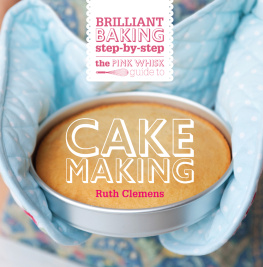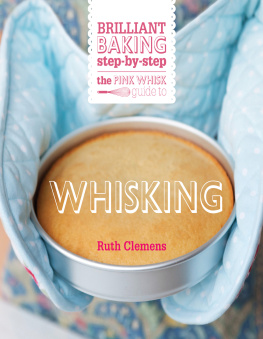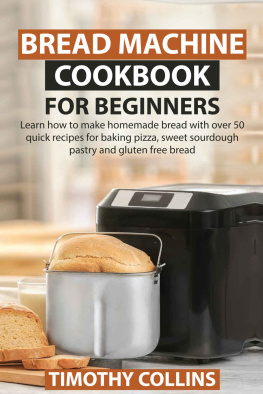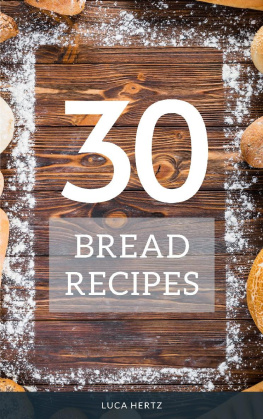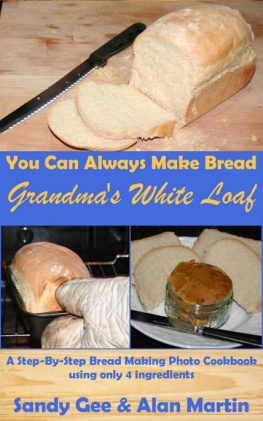Bread should be sliced with a sharp serrated bread knife in a sawing motion this stops the bread becoming compacted when it is cut.
Tip
Good quality tins (pans) will always stand you in good stead: they distribute heat evenly and will give you a better bake. Look after them and theyll look after you! They should be hand washed in warm soapy water dont go sticking them in the dishwasher. They will build up a patina over time that makes their performance better.
Ingredients
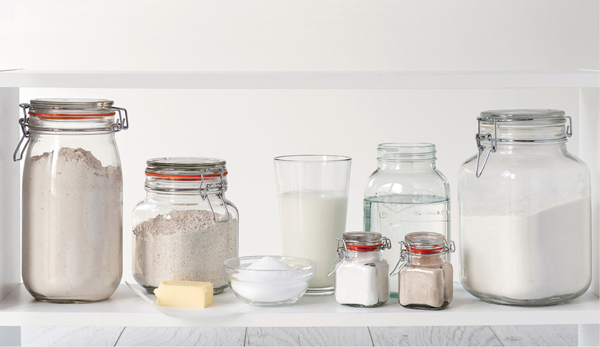
Strong / Bread Flours
The main ingredient in bread making, bread flour is higher in protein than plain (all-purpose) flour and therefore produces the high gluten level needed for bread making. Flours for bread making will vary in protein content but are generally over 11 per cent and often up to 15 per cent.
Strong white bread flour
Its worth sticking with one type of strong white bread flour as different brands will vary in their absorbency of liquid. That way youll get to know your flour and can note down any recipe adjustments you need to make for next time.
Malted Bread Flour
A mix of strong wholemeal (whole wheat) bread flour, malted wheat flakes and grains for sweeter, nuttier loaves.
Wholemeal (whole wheat) bread flour
This has slightly lower gluten than white bread flour, which is why it is often mixed with white bread flour in recipes, rather than used on its own. It will absorb much more liquid than white bread flour. It has a nutty taste, and as it contains wheat germ and bran its good for you. The bran content will inhibit the rise in the dough so it will need longer to prove and bake, and will produce a denser, coarser loaf.
Yeast
Yeast is used to make the dough rise by aerating it, which gives it a light, open texture. The yeast needs warmth, moisture and nutrients (starch from the flour plus sugar and salt) to multiply and grow. Too much of any of these and it will be killed, resulting in a failed loaf.
All of the recipes in this book can be made using any type of yeast. Both fresh and dried yeast will need to be soaked in a little of the liquid from the recipe until the mixture starts to bubble and froth. Calculate the amounts needed using the following conversion:
1 tsp fast action yeast = 6.5g (oz) fresh yeast = 3.5g (1tsp) dried yeast
Fast action yeast
Also referred to as quick, instant, fast dried and easy blend yeast, this is often sold in sachets to help keep its freshness. It is my preferred choice for yeast and the recipes here all use it. It doesnt need reconstituting with water first and can be added directly to the bowl with the other ingredients. Be sure to check your yeast is within its use-by date.
Dried yeast
This yeast is in a pellet form, which needs to be soaked in water before using.
Fresh yeast
This can be difficult to get hold of, but try health food or wholefood shops they will often have it in the chiller cabinet. It comes in a block and is beige in colour with a creamy texture and yeasty smell. It keeps for approximately 1 week in the fridge but will quickly discolour, dry out and lose efficacy so buy it as you need it.
Salt
This enhances the flavour of bread, helps to strengthen the gluten, and acts as a preservative. Too much will kill the yeast. It wont harm fast action yeast if it comes into contact with it in the mixing bowl but be careful with fresh and reconstituted dried yeast, placing them away from salt in the bowl prior to mixing. Sea salt can be used instead of table salt but it should be finely ground first.
Sugar
Caster (superfine) or granulated sugar in savoury doughs acts as source of food for the yeast. It can be used in a greater quantity to sweeten doughs and darken a crust. It is sometimes added in the form of honey, treacle (molasses) or malt extract which will not only add sweetness but also flavour and colour.
Liquids
Some doughs are more hydrated than others and liquid can be added in all sorts of forms; water, milk, apple juice and so on. Liquids should be warmed to blood temperature so that the temperature of your finished dough is warm enough for the yeast to be activated. Too hot and the yeast will be killed, too cold and the dough will be slow to rise. One part boiling water to two parts cold water gives the correct temperature. For a pre-ferment cold liquid is fine. Milk will provide a finer textured crumb than water due to the fat content. The liquid measurements in the recipes should be used as a guide as you get to know your flour you may need to make little adjustments. Just make sure you note them down for next time.


